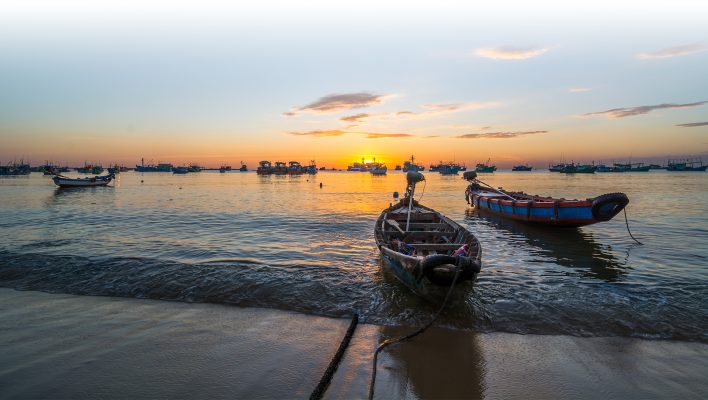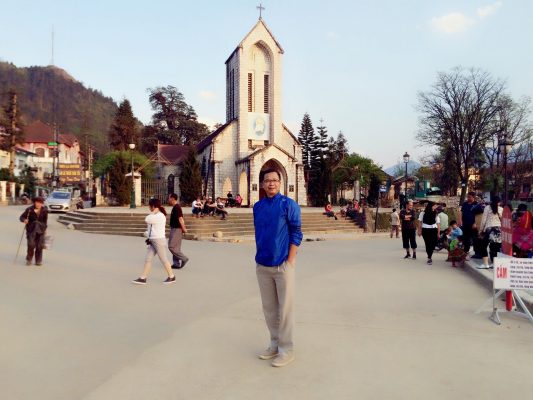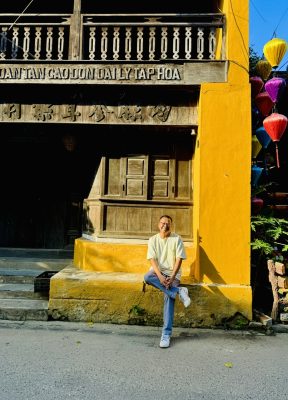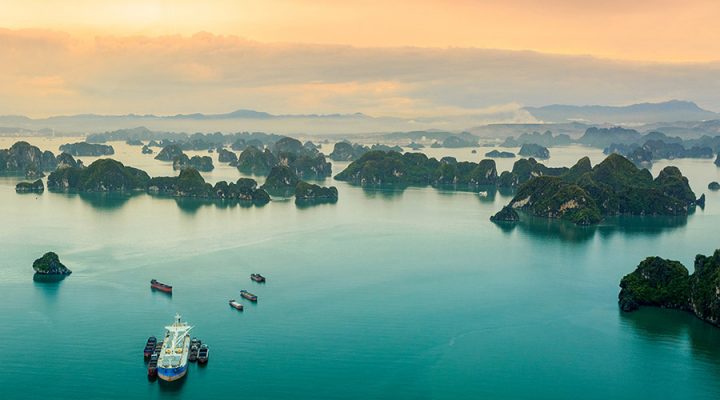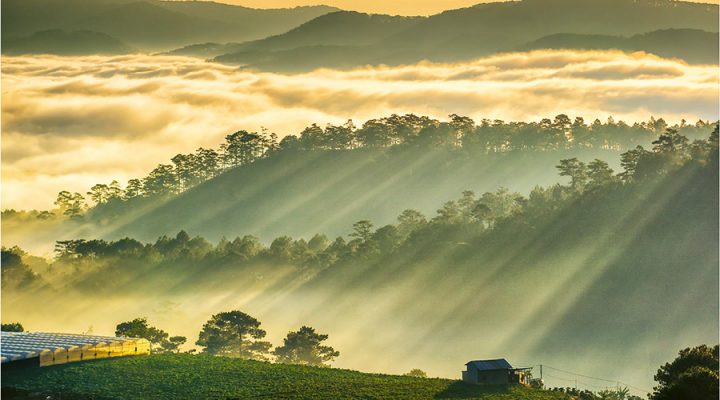Vietnam
(By Remote Lands)
Vietnam is a tropical land of outgoing people, bustling capitalist-oriented cities, heavenly beaches, brilliant green rice paddies and lush emerald rainforests. Like the rest of Indochina (including Laos and Cambodia), Vietnam is a former French colony and has been independent since 1954 – when the French Foreign Legion suffered a telling blow at Dien Bien Phu. Vietnam still retains a strong French cultural influence, with wide boulevards, magnificent Belle Époque architecture, fresh baguettes sold on every corner, good espresso and fine Bordeaux at open air cafes widely available.
The Vietnamese are much closer culturally to China, with Confucian ethics valuing age, education and hard work. The Vietnam War has long since been forgotten and the people are exceedingly warm and hospitable. The nation features temples, historic ports, a bevy of unspoilt tropical islands, museums, art, and over 50 hill tribes. From the big cities to the rice bowl of the south, Vietnam has it all.
Vietnam has three separate weather patterns. The South is best between December and March, the North in spring (March to May) and fall (September to November), and Central Vietnam is best visited between February and July. Countrywide, December and February is the perfect time to visit, when rain is minimal, although the North will be chilly.
HANOI
Settled since prehistoric times, Hanoi has been an important city throughout Vietnamese history, serving as the capital of a number of Vietnamese dynasties. Following the end of the Vietnam War, Hanoi became the capital of the country.
Today, Hanoi provides a rich blend of new and old Vietnam, from the thousands of young workers on scooters streaking down the wide Parisian-style boulevards, to the chic fusion restaurants housed in former colonial buildings. Even as the city buzzes with heavy development and modernization, it retains its idyllic charm. Enjoy Hanoi’s tranquil parks and lakes, peruse galleries filled with emerging Vietnamese artists and fashion designers, and sample the city’s amazing cuisine and bustling street life.
HALONG BAY
Approximately a three-hour drive east of Hanoi, Halong Bay is a breathtaking landscape of 1,969 densely clustered limestone islands, arches and pinnacles rising right out of the emerald waters. Designated a World Heritage Site by UNESCO for its surreal beauty, Halong Bay is one of Vietnam’s top destinations.
SAPA
Built in the 1920s as a hill station for the French armed forces, Sapa was re-discovered in recent years as a tourist destination. A mountainous area on the Vietnam-China border, Sapa sees 160 days a year of mist and rain, and is home to a wealth of ethnic minorities and hill tribes. Among them are the H’mong, the Dao, and the Montagnards, the “Mountain People”, who cooperated closely with American forces in the Vietnam War. Many French-era colonial buildings remain in the area, lending Sapa a genteel, nostalgic air.
HUE
For over a hundred years, the city of Hue was home to the capital of Vietnam under the emperors of the Nguyen Dynasty. Because of this legacy, Hue brims with a wealth of cultural and historic treasures, from imperial tombs to the ruined palaces of the Forbidden Purple City, where only the emperors, concubines and members of their households were permitted – and where trespassers were put to death.
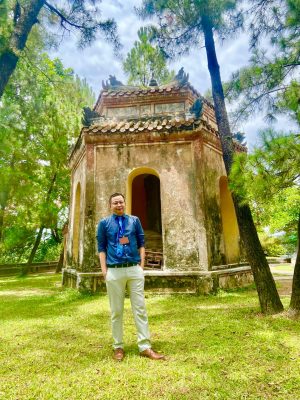
DANANG & HOIAN
From the 1600s to the 1800s, Hoi An was a major trading outpost known as Faifo. However, when the river silted up and the harbor became too shallow, trade moved north to Da Nang – and Hoi An lost its significance. Today, this cosmopolitan heritage is reflected in its mix of Japanese, Chinese, and Vietnamese influences. Because of its rich blend of aesthetics, the entire old city is a UNESCO World Heritage Site.
NHA TRANG
A lively coastal city, Nha Trang overlooks the aquamarine waters of the South China Sea. While the city today is a modern, pleasant town, the area itself was quiet and undeveloped until the arrival of the French – who immediately set about transforming it into a seaside resort. Even during the turmoil of the Vietnam War, Nha Trang was a popular vacation destination for soldiers on leave; this trend continues today with an influx of tourists and sightseers.
While Nha Trang,s main beach is perhaps not as radiant as it once was, there are a number of sandy areas nearby that are still exceedingly beautiful, including the secluded, quiet Doc Let beach. Most visitors to the area frequent Nha Trang,s luxury resorts, the best of which is the Six Senses Ninh Van Bay, which features quiet, secluded villas with panoramic views of the nearby South China Sea. Additionally, another famous sight is the Po Nagar Towers, a series of monuments dating back to the Cham Empire, a Hindu civilization that once ruled much of southern Vietnam.
DALAT
The capital of Lam Dong province, Dalat is located in Vietnam’s south-central highlands, just under 200 miles from Ho Chi Minh city. Pleasantly sized, it’s as easy to get around as it is on the eye. Remnants of the French colonization remain; favoring the city’s cooler climates, the French built their holiday chalets and villas here, giving Dalat a charming alpine feel that is only emphasized by the pine forests at its edges. Known as “Petit Paris”, it’s less frenetic than its namesake; the friendly and welcoming urban center has a calm, slow pace and soon gives way to the lakes and rolling green hills with which it is surrounded, a backdrop of misty mountains in the background. Visitors to Dalat – glad of the respite from the rest of the country’s heat – will enjoy its pretty streets, quaint shops and excellent food, spanning the gamut from European to Asian. Activities and day trip options are many and varied, from a round of golf on a royal course, to an afternoon boating on the lake, or exploring the city’s architectural wonders, there’s something to suit all tastes.
SAIGON
For over a hundred years, Saigon was the capital – first under the French colonizers, and later the regime of South Vietnam. Following the end of the Vietnam War, Saigon was renamed Ho Chi Minh City, though locals still refer to it by its old name. Today, Saigon is the industrial and commercial heart of the country, attracting green youth and seasoned businessmen alike with its rapid expansion and numerous opportunities. While development is rampant, the city still retains infrastructure from its days as the colonial capital – with quaint, European-style architecture alongside newly-constructed commercial buildings.
BEN TRE
Sandwiched between two major branches of the Tien Giang River, Ben Tre is situated on a small island in the Mekong Delta known among other things for its fruit production, its tranquil atmosphere, and as the site of the first Viet Cong victory at the start of the Vietnam war. Once infamous as the village that had to be “destroyed in order to be saved” by American forces, the small town is now a wonderful place to experience the charms of the Mekong Delta. Today, Ben Tre is a tranquil, serene town, whose highlights include old villas, beautiful countryside, and a fascinating, teeming wet market.
CHAU DOC
Located in the west of the Mekong Delta, near the border with Cambodia, Chau Doc lies 174 miles (280 miles) southwest of Saigon. A recent addition to Vietnamese territory, Chau Doc was given as a gift from the Cambodian monarch in return for Vietnamese aid in putting down an insurrection. Centuries of trade along the river have created a unique culture, a fusion of Khmer, Chinese, and Vietnamese influences.
PHU QUOC
Boasting spectacular mountain scenery, friendly, laid-back locals and arguably the country’s best beaches, Phu Quoc is Vietnam’s very own tropical paradise. Located in the Gulf of Thailand, 45km from Vietnam and just 15km from Cambodia, the island is home to a growing number of luxury resorts and welcoming an increasing number of visitors, while retaining much of its sleepy rural charm. Capital Duong Dong is home to most of the resorts as well as some superb seafood restaurants, a lively night market and what passes for the island’s nightlife; elsewhere you’ll find deserted beaches, dirt roads, rainforests, and fishing villages exhibiting a way of life unchanged for centuries. Local specialities include black pepper from the island’s many plantations and Phu Quoc fish sauce, claimed by many to be the world’s finest. It’s a short flight from Ho Chi Minh City or an even shorter one from Can Tho for those who want to combine a few days’ relaxing on the beach with a visit to the fascinating Mekong Delta.